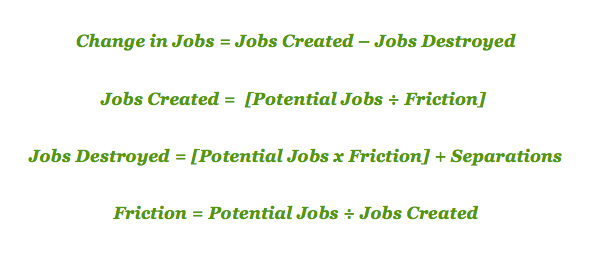How more jobs would be created if hiring was made easy.
1. Introduction
Search costs for match quality within hiring decisions create friction that increases the time to hire for open jobs, leaves some open jobs permanently unfilled, reduces the amount of “opportunity hires,” and ultimately, limits business output.
In reducing search friction for jobs, the labor market will fill open jobs faster (Part 2), destroy less open jobs (3), improve match quality (4), and create more jobs from the opportunity effect of increased liquidity (5).
Let’s examine each clause with formula in mind:
Change in Jobs = Jobs Created – Jobs Destroyed
Jobs Created = [Potential Jobs ÷ Friction]
Jobs Destroyed = [Potential Jobs x Friction] + Separations
Friction = Potential Jobs ÷ Jobs Created
Friction is measured as a coefficient. Friction is inversely related to jobs created and directly related to jobs destroyed. The less friction in the labor market, the easier it is to create and fill a job. The more friction there is, the harder it is to create and fill jobs.
2. Fill Open Jobs Faster
Change in Jobs (↑) = Jobs Created (↑) – Jobs Destroyed
Jobs Created (↑) = Potential Jobs ÷ Friction (↓)
This is the simplest piece of the puzzle. If there is less friction in the labor market, open jobs will be filled faster.
3. Destroy Less Open Jobs
Change in Jobs (↑) = Jobs Created – Jobs Destroyed (↓)
Jobs Destroyed (↓) = [Potential Jobs x Friction (↓)] + Separations
Many open positions are destroyed because a company can only exhaust a limited expenditure to fill a position. Friction in the labor market pushes a company toward that threshold point. After absorbing enough friction, a company that was willing to pay for job will stop spending resources on searching for the right hire. If friction in the labor market declines, the number of potential jobs that remain permanently unfilled (i.e. potential jobs destroyed by search friction) will also decline.
4. Match Quality Improved
Change in Jobs (↑) = Jobs Created – Jobs Destroyed (↓)
Jobs Destroyed (↓) = [Potential Jobs x Friction] + Separations (↓) ]
If a better hire is made, the average duration of employment will be longer. Better match quality leads to a higher rate of production, fewer separations, and better morale because workers do what they agreed to do. Hiring is cyclical. Better match quality will create more production. Additionally, this increased liquidity can improve retention (i.e. decrease separations) by increasing wages.
5. Create More Jobs from the Opportunity Effect of Liquidity
A decrease in cost and time to hire will increase a business’ liquidity. In the long run, more liquidity leads to more open positions. Moreover, potential jobs consists of publically open jobs and opportunity hires. An opportunity hire occurs when a company is not actively trying to hire for a position, but talent presented itself, and the business has the liquidity to make the hire.
Change in Jobs (↑) = Jobs Created (↑) – Jobs Destroyed
Jobs Created (↑) = [Open Jobs (↑) + Opportunity Hires (↑)] ÷ Friction
When a business does not hire because of a lack of liquidity, search friction is created. Thus, increased liquidity allows businesses to make more safe hiring transactions and more speculative hiring transactions when opportunities to acquire great talent are present.
6. How would more jobs be created if hiring were made easy?
If search friction for match quality is decreased in the labor markets: cost and time to hire would decrease (part 2), less open jobs would be destroyed (3), business’ would have more liquidity, the average hire would have more daily output over a longer period (4), and opportunity hires would increase in addition to creation of more open jobs (5).
When hiring is made easy:
Change in Jobs (↑) = Jobs Created (↑) – Jobs Destroyed (↓)
David Smooke graduated Cum Laude in Economics from the University of Redlands in 2010. SmartRecruiters provides free technology to revolutionize the labor market.
